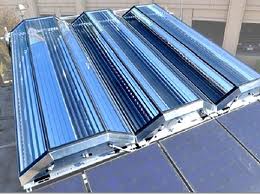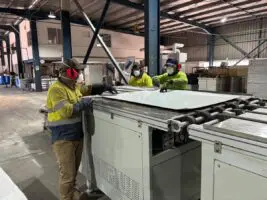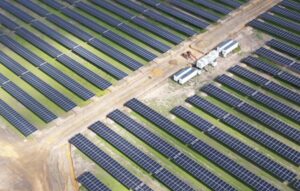At last, a potential good news story about Australian solar technology and its ability to be developed in its home country.
The Australian Solar Institute is sponsoring a $9.6 million project to return an Australian-developed solar thermal technology to its birthplace and establish a manufacturing base for the product, which could deliver highly efficient combination of electricity, heating and cooling to industrial and commercial rooftops.
The technology is a spin-off from the Compact Linear Fresnel Technology developed by the Australian founded Ausra, which eventually set up shop in California after being starved of opportunities in Australia and was ultimately sold to French nuclear giant Areva. That technology is now proposed for the $1.2 Solar Dawn project in Chinchilla in Queensland, and is being installed as part of a 44MW solar booster unit at the neighbouring Kogan Creek coal-fired power station. It is also being deployed at scale in India.
While the utility-scale technology is no longer in Australian hands, a rooftop version is owned by Chromasun, a company headed by one of the co-founders of Ausra, Peter Le Lievre, and the IP remains Australian owned. The chief engineer, Andrew Tanner is a University of Sydney graduate who was founding engineer at Ausra, and chief operating office Mikal Greaves is also Australia.
The ASI project is designed to see if the technology can be returned to Australia, where a manufacturing base can be established for deployment for the domestic market and for export to Asia and the Middle East.
“Chromasun is still majority Australian owned,” Le Lievre told RenewEconomy in an interview. “We hope to keep as much in Australian hands as long as possible. But it is only in the last year or two that we have we seen Australia have the right policy settings and the right market to sustain a company like ours.” He specifically mentions initiatives such as the ASI funding, the carbon price and the Clean Energy Finance Corp. “This is very much a coming home – certainly on the manufacturing side.”
Le Lievre says the technology is similar to the utility-scale units – it has just been “miniaturised and put in a box” with the help of researchers from the ANU. Light enters the glazing of the micro-concentrator (MCT), is reflected off Fresnel mirror strips and is then concentrated on the receiver.
Le Lievre says it can deliver heat of up to 204C – considerably hotter than other solar thermal systems used for residential water – and is suitable for industrial and commercial rooftops.
The ASI-sponsored project will be in several stages. In one of two initial pilot projects, its MCT units will be installed on the roof of Echuca Hospital in Victoria, where it will be coupled with a double-effect absorption chiller to provide air conditioning directly from sunlight.
Another project – on the rooftop of the Little Creatures Brewery in WA – will combine the MCT unit with an ammonia chiller to simultaneously provide chilled water and heat for boiler feedwater.
In the second phase of the project, MCT units will be hybridised with CPV units at pilot facilities at ANU in Canberra and the University of Queensland in Brisbane to provide both electricity and hot water. The first ever such hybrid unit was installed by the company in San Jose last December.
Le Lievre said the technology is well established, and it was inevitable that it would develop into a hybrid product. “The technology is fairly straight forward and a natural extension of the utility scale (Ausra) technology,” he said. “It has the same functionality but in a rooftop product.”
He says because the hybrid product combines electricity production with heating and cooling, it should work at around 75 per cent efficiency, compared with up to 20 per cent for the best rooftop PV panels. The ability to drive high efficiency chillers and heat for boiler feedwater could be useful for a range of industries such as food, beverages, and steam laundries, as well as energy-intensive facilities such as hospitals and sports centres.
ANU Dr Vernie Everett says he believes the MCT Hybrid project represents the best opportunity for establishing hybrid rooftop concentrators to provide greenhouse neutral energy independence, for homes as well as industrial facilities. “An integrated system comprising several MCT units can provide all the electricity, hot water, space heating, and solar cooling for conventional houses,” he says.
Chromasun will be working with auto-parts group Futuris to improve the design of the products and to use them as a contract manufacturer.
Chromasun is currently running a small manufacturing facility with capacity of 10MW a year near San Jose in California, and it has an installation in a building in Abu Dhabi. Le Lievre said the commercial environment for the development of technologies such as his had been compromised by plunging gas prices in the US, and this provided an opportunity for Australia to develop and manufacture the product.
“The cost of gas and electricity in Australia is rising to a point where renewable technologies can compete,” Le Lievre says. “If you are a hospital or an industrial facility with a big roof and a large energy load, we can become a very attractive proposition.”








